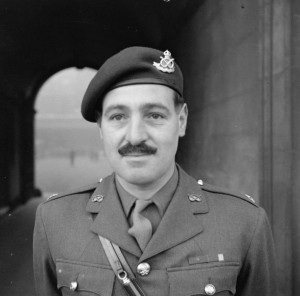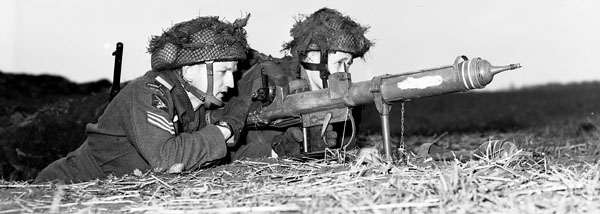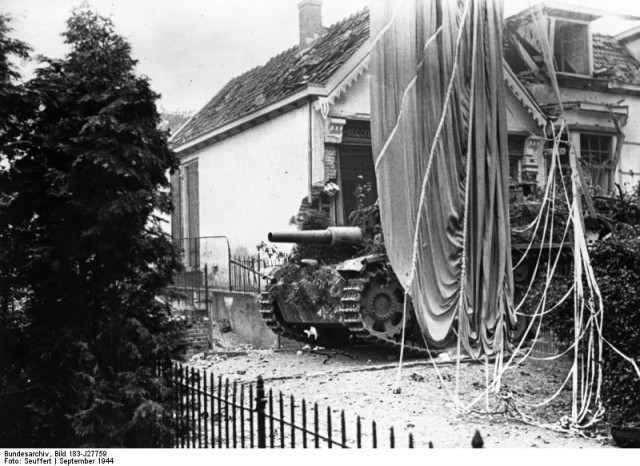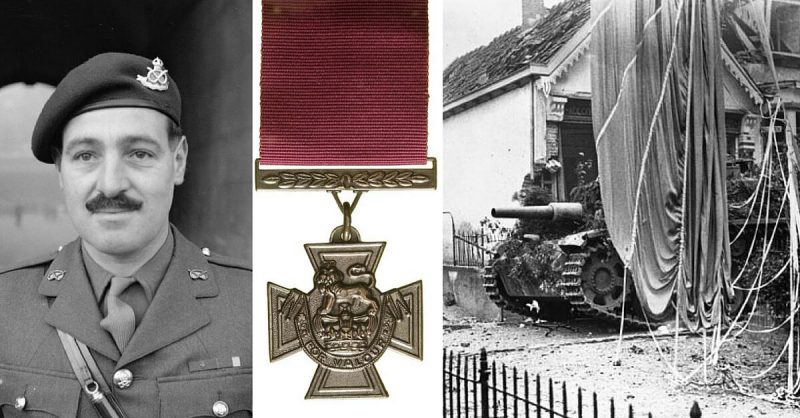Major Robert Cain was awarded the Victoria Cross in the battle for Arnhem. He was the sole recipient, out of the five Victoria Crosses awarded during that battle, who survived.
Major Cain was the commander of B-Company 2nd South Staffordshire Regiment, a glider-borne unit in the 1st Airborne Division. He left England on September 17th England from Manston Airfield, destination Landing zone Z near Wolfheze. His flight was a short one because after 5 minutes his tow rope snapped.
The glider made a perfect landing in some fields, tearing through a hedge. While the soldiers began unloading the glider one of the Gilder Pilots found a telephone made a call to Manston. The Gilder Pilot who examined the tow rope said it was ‘diabolical’ as the same thing happened to him on D-Day. They all got back to the airfield and got into a new glider on September 18th in the Second lift. This time, they landed on the landing zone without further incident.

Arnhem
Meanwhile, his company was heavily engaged in the attempt to reach the Bridge at Arnhem. They were to break through to the 2nd Battalion that was holding on to the north end. Major Cain finally joined his company on early in the morning on September 19th at the Utrechtseweg in Arnhem.
His B-Company, together with A-Company was in the middle of its attack that ran into heavy opposition just beyond the Municipal Museum. The Germans were supported by (Stug III) self-propelled guns and had blunted the assault, inflicting terrible casualties on the lightly armed glider troopers.
Major Cain found himself in a hollow in the slope outside the museum (position one on the map). They were under constant tank fire and only had PIATs as an anti-tank weapon. Lieutenant Dupenois was with him in the hollow, and he fired the PIAT while Major Cain tried to draw fire and get ammunition. This way they were able to hold off the Germans for 2 to 3 hours until their PIAT ammunition ran out.

The PIAT launched a 2.5 pound (1.1 kg) bomb using a powerful spring and a cartridge in the tail of the projectile. It possessed an effective range of approximately 115 yards (110 m) in a direct fire anti-tank role. The PIAT had several advantages over other infantry anti-tank weapons of the period, which included a lack of muzzle smoke to reveal the position of the user. However, this was countered by a difficulty in cocking the weapon, the bruising the user received when firing it, and problems with its penetrative power.
Being under fire from the roads below and above them their position became untenable, and they had to withdraw. Only Major Cain and a few men managed to get away from what they called “a death trap.” A- and B-Company, 2nd South Staffords ceased to exist with most of their men killed, wounded or taken prisoner.
Major Cain then took over C-Company and the remaining men of the 2nd South Staffords. With this force, he got on the high ground near Den Brink (location 2 on the map above), but they were soon spotted by the Germans who started to shell the area with mortars. The ground was too thick with roots to dig in and they suffered heavy casualties. When they were then attacked by tanks, Cain decided to pull back to Oosterbeek. He felt very dejected as they could not break through to the bridge and were thrown out of the town.
Oosterbeek
Together with the remains of the Parachute Brigade, they marched out of Arnhem and towards Oosterbeek. There Major Cain was ordered to take command of the mixed parties that were now assembling around the Church on the lower road near the river. This became his area during the defense of the Oosterbeek Perimeter. By nightfall of the 19th of September, he commanded the remaining 100 men of the 2nd South Staffords.
On September 21st the Germans launched a major assault down the Ploegseweg of infantry supported by self-propelled guns. Their aim was to try and cut the British off from the river, sealing the fate of the 1st Airborne Division. During this attack, Major Cain grabbed a PIAT and started to engage the attacking tanks.
He lobbed around 50 PIAT Bombs over a house on the advancing tanks. He was getting directions from an artillery officer in a house while he was in a slit trench. Tank fire hit the house, killing the officer and dropping the chimney almost on top of Major Cain.
Another Stug came down the road, and Cain crawled to the corner of his trench to engage it. He fired his PIAT from 30 yards away and probably hit the tank on the tracks. The tank fired back immediately but missed throwing up a huge cloud of smoke and dust. As soon as he could see the tank again, he fired his second PIAT bomb after which the tank fired a second time.
A 75mm Howitzer was quickly manhandled forward to an exposed position where it could finish off the tank with an armour piercing round. It took a while for the smoke and dust to clear. When it did Major Cain saw the crew bailing out, they were engaged by Bren guns and killed.

He then engaged another tank, but his PIAT bombs exploded in front of his face. It blew him over backwards and with bits of stuff in his face and temporarily blind. He was, as he said himself, “shouting like a hooligan. I shouted for somebody to get onto the PIAT because there was another tank behind”.
By now the Germans had enough and retreated the way they came.
Major Cain was dragged to an Aid post but quickly recovered and within 30 minutes he returned to the front line. For this action, he was awarded the Victoria Cross.
His Victoria Cross citation states that his leadership ensured that the South Staffordshire gave no ground and drove the enemy off in complete disorder. By the end of the Battle, Major Cain had been reportedly responsible for the destruction or disabling of six tanks, four of which were Tigers, as well as a number of self-propelled guns.
On the last day in the perimeter, September 25th, Major Cain was still in his slit trench engaging the enemy. By now the PIAT munition had run out, and he equipped himself with a 2inch mortar with which he engaged the enemy.
That night the division escaped across the Rhine River, Major Cain ensured his men were all across before he himself crossed the Rhine river.
The Victoria Cross Citation:
War Office, 2nd November, 1944.
The KING has been graciously pleased to approve awards of the VICTORIA CROSS to: —
Captain (temporary Major) Robert Henry Cain (129484), The Royal Northumberland Fusiliers, (attd. The South Staffordshire Regiment) (I Airborne Division) (Salcombe, Devon).
In Holland on 19th September 1944, Major Cain was commanding a rifle company of the South Staffordshire Regiment during the Battle of Arnhem when his company was cut off from the rest of the battalion and during the next six days was closely engaged with enemy tanks, self-propelled guns, and infantry. The Germans made repeated attempts to break into the company position by infiltration and had they succeeded in doing so the whole situation of the Airborne Troops would have been jeopardised.
Major Cain, by his outstanding devotion to duty and remarkable powers of leadership, was to a large extent personally responsible for saving a vital sector from falling into the hands of the enemy.
On 20th September a Tiger tank approached the area held by his company, and Major Cain went out alone to deal with it armed with a Piat. Taking up a position he held his fire until the tank was only 20 yards away when he opened up. The tank immediately halted and turned its guns on him, shooting away a corner of the house near where this officer was lying.
Although wounded by machine gun bullets and falling masonry, Major Cain continued firing until he had scored several direct hits, immobilised the tank and supervised the bringing up of a 75 mm. Howitzer which completely destroyed it. Only then would he consent to have his wounds dressed.
In the next morning, this officer drove off three more tanks by the fearless use of his Piat, on each occasion leaving cover and taking up position in open ground with complete disregard for his personal safety.
During the following days, Major Cain was everywhere where danger threatened, moving amongst his men and encouraging them by his fearless example to hold out. He refused rest and medical attention in spite of the fact that his hearing had been seriously impaired because of a perforated eardrum, and he was suffering from multiple wounds.
On 25 September the enemy made a concerted attack on Major Cain’s position, using self-propelled guns, flame throwers, and infantry. By this time the last Piat had been put out of action and Major Cain was armed with only a light 2″ mortar. However, by a skilful use of this weapon and his daring leadership of the few men still under his command, he completely demoralized the enemy who, after an engagement lasting more than three hours, withdrew in disorder.
Throughout the whole course of the Battle of Arnhem, Major Cain showed superb gallantry. His powers of endurance and leadership were the admiration of all his fellow officers and stories of his valour were being constantly exchanged amongst the troops. His coolness and courage under incessant fire could not be surpassed.
Note that his citation contains 2 errors, the action took place on the 21st of September and a Stug III was destroyed, not a Tiger tank.
